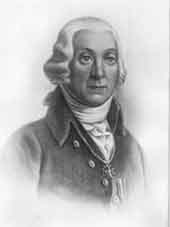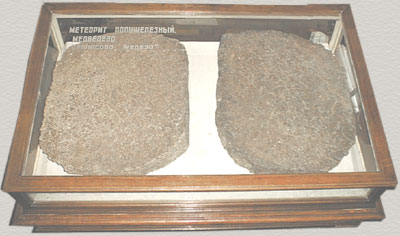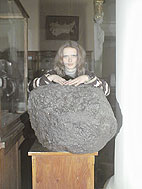Exposition "Meteorites"
 The first specimen of the
museum meteorite collection collection was a piece of iron-stone meteorites
called "Pallasovo Zheleso" (Pallas's Iron) discovered by one of former
directors of the museum - academician P.S.Pallas (1741-1811) in Medvedevo village,
Kranoyarsk region, Siberia during one of the Great Siberian expeditions.
The meteorite itself was found in 1749 by a local smith who was going to utilize
the good meteorite iron. It took ten years for delivery by horse a piece from
Siberia to Sankt-Petersburg. Finally the 687 kg lump had arrived tomineral cabinet
in 1772. Later the whole piece was cut to two parts which you can see on the
exhibit together with the natural size gypsum model of uncut piece.
The first specimen of the
museum meteorite collection collection was a piece of iron-stone meteorites
called "Pallasovo Zheleso" (Pallas's Iron) discovered by one of former
directors of the museum - academician P.S.Pallas (1741-1811) in Medvedevo village,
Kranoyarsk region, Siberia during one of the Great Siberian expeditions.
The meteorite itself was found in 1749 by a local smith who was going to utilize
the good meteorite iron. It took ten years for delivery by horse a piece from
Siberia to Sankt-Petersburg. Finally the 687 kg lump had arrived tomineral cabinet
in 1772. Later the whole piece was cut to two parts which you can see on the
exhibit together with the natural size gypsum model of uncut piece.
The name "Pallas Iron" was given to that meteorite by academician
E.F.Chladni (1756-1794). He founded the piece turned out to be an olivine and
nickel iron mixture. The mineralogical composition of the piece was very different
compare to earth stones so E.F.Chladni suggested the piece came from the sky.
Studying that stone E.F.Chladni made a significant contribution to the meteoritic
science. After him all meteorites with the composition and structure similar
to "Pallasovo zheleso" (containing about equal amounts of olivine
and nickel-iron) were given the name "pallasites".

Two pieces of meteorites |

Gypsum model of Pallasovo Zheleso |
 The first specimen of the
museum meteorite collection collection was a piece of iron-stone meteorites
called "Pallasovo Zheleso" (Pallas's Iron) discovered by one of former
directors of the museum - academician P.S.Pallas (1741-1811) in Medvedevo village,
Kranoyarsk region, Siberia during one of the Great Siberian expeditions.
The meteorite itself was found in 1749 by a local smith who was going to utilize
the good meteorite iron. It took ten years for delivery by horse a piece from
Siberia to Sankt-Petersburg. Finally the 687 kg lump had arrived tomineral cabinet
in 1772. Later the whole piece was cut to two parts which you can see on the
exhibit together with the natural size gypsum model of uncut piece.
The first specimen of the
museum meteorite collection collection was a piece of iron-stone meteorites
called "Pallasovo Zheleso" (Pallas's Iron) discovered by one of former
directors of the museum - academician P.S.Pallas (1741-1811) in Medvedevo village,
Kranoyarsk region, Siberia during one of the Great Siberian expeditions.
The meteorite itself was found in 1749 by a local smith who was going to utilize
the good meteorite iron. It took ten years for delivery by horse a piece from
Siberia to Sankt-Petersburg. Finally the 687 kg lump had arrived tomineral cabinet
in 1772. Later the whole piece was cut to two parts which you can see on the
exhibit together with the natural size gypsum model of uncut piece. 
